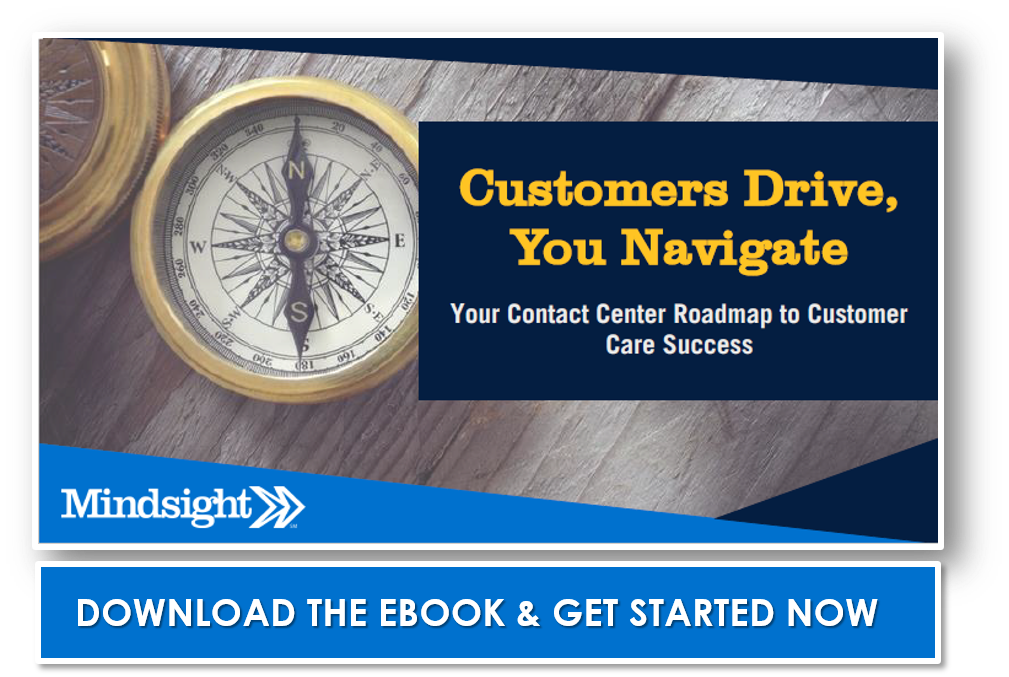March 13, 2018
Management consultant, educator, and author, Pete Drucker, once said, “If you can’t measure it, you can’t manage it.” Despite the sophisticated technology and resources at our disposal, the same is true today. Without a real, measurable awareness of how a contact/call center is truly performing, it is impossible to know where the team’s strengths and weaknesses are. Any initiatives to increase the revenue generated by the contact center will be conjecture at best.
If you are considering enacting a plan to improve your contact center results, check our our free eBook Customers Drive, You Navigate: Your Contact Center Roadmap to Customer Care Success.
Yet, contact centers today have a leg up on those that came before them. With the added resources of the digital age, almost every aspect of a customer’s interaction with the contact center can be recorded, tracked, organized, and analyzed using contact center platforms such as Cisco Unified Contact Center Express (UCCX) or Customer Interaction Center (CIC). These metrics are called key performance indicators (KPIs), and every contact center should assemble a collection of those most relevant to their business objectives.
With the progression of their KPIs in hand, contact center managers can make educated decisions as to how to improve their contact centers based on real evidence. The trick is finding which KPIs work for you. Below, we’ll discuss some of the most important KPIs for a majority of contact centers as well as ways to improve these scores.
Aligning Key Performance Indicators with Business Objectives
Before acting on any of the data gathered, there are factors to be considered. It can be tempting to look at each performance indicator in isolation and try to focus optimization on that metric. Yet, every contact center must be aware of the larger objectives of the business and how that shapes their interactions with the customer. Depending on the industry, measuring and improving your KPIs may not be so straight forward.
Average call length is a perfect example. Common intuition dictates that a contact center spending less time on each individual call can take on more calls in a day, promote their brand to more customers, and ultimately drive more sales. However, this may not be the case for every contact center.
KPIs in Conflict with Business Objectives
Suppose a contact center for a landscaping company was trying to cut down on their average time per call. Certainly, their profit came from large projects throughout the community like building decks, planting gardens, etc. More time to accept additional calls would be beneficial, but in ushering agents off the phone and on to the next call, they forego the opportunity to push additional services. Alternatively, some clients simply require a longer time to warm to a conversion.
This is just one example, but no KPI exists in isolation. Assess what sacrifices are made when devoting focus to a specific KPI and how it impacts the rest of your metrics. The effects may not be immediately obvious, so be sure to regularly analyze the metrics for trends at play.
Key Performance Indicators to Measure
Average Speed of Answer (ASA) / Service Level Response Time (SLRT) / Average Wait Time (AWT):
Though known by many different names, this is perhaps the most important KPI. It measures the average time it takes for a customer to call in and begin speaking with a representative. In our fast paced internet culture, people want instant gratification. By improving this metric, the contact/call center can increase customer satisfaction and conversion rates as well as reduce abandoned call rates.
First Call Resolution (FCR):
Another essential KPI, FCR, has a direct relationship with customer satisfaction in most industries. This is especially true in those contact/call centers focusing on customer service and quality assurance. The more often a customer needs to contact an agent, the slimmer their patience will become. Try refining your call script (or developing one) to better guide the caller to the next step in the sales process.
Abandoned Call:
This metric measures the percentage of callers who give up on the call before reaching an agent for whatever reason. They could be frustrated with the interactive voice recording (IVR) or long hold times. Look at the lengths of these calls and listen to recordings to see if the reason for abandonment can be narrowed down. From there it could require a streamlining of the IVR or a concerted effort to reduce the ASA.
Conversion Rate:
 Whether booking appointments or selling products, the conversion rate is the best indicator of success. Of all the calls received, how many take the desired action? However, improving this score is more nebulous than most. The conversion rate is actually the culmination of effective and ineffective strategies across the contact/call center and beyond. Even outside departments like marketing play a role in warming these leads for a successful conversion. If the conversion rate is low, it could be a weak call script, overpriced products, clumsy IVR, long hold times, or even a poor brand image. To improve this score, we recommend focusing on the smaller components that impact the other metrics. The rest will follow naturally.
Whether booking appointments or selling products, the conversion rate is the best indicator of success. Of all the calls received, how many take the desired action? However, improving this score is more nebulous than most. The conversion rate is actually the culmination of effective and ineffective strategies across the contact/call center and beyond. Even outside departments like marketing play a role in warming these leads for a successful conversion. If the conversion rate is low, it could be a weak call script, overpriced products, clumsy IVR, long hold times, or even a poor brand image. To improve this score, we recommend focusing on the smaller components that impact the other metrics. The rest will follow naturally.
Customer Satisfaction Rate:
If you want to know if your customers enjoy their experience with your organization, sometimes it is easiest just to ask them. Some may not be interested in providing feedback, but with the right strategy in place, this can be very valuable information to reference.
Average Call Length:
The difficulty with this KPI was stressed in the “KPIs Conflict with Business Objectives” section above. The takeaway here is that it simply may not be relevant to certain contact/call centers, but for others, it could be the most important metric measured. It’s essential then to understand the company’s sales cycle, the contact/call centers role in this process, and where the profit comes from. The larger scope of the organization’s strategy will dictate the importance of call length.
Agent Schedule Adherence:
This metric measures how effectively the agents are using their time for work activities. After a break, how long is it before they are back on the phones? If ASA is becoming a problem in the contact/call center, it may be pertinent to make sure the staff is putting forth the effort.
That being said, 100% utilization is simply unrealistic. We recommend that contact/call center managers use 80% utilization as a benchmark for a hardworking, diligent contact/call center.
Service Level Agreement (SLA):
Not every B2C contact/call center has an SLA with their customers, but this metric should be front and center in the mind of 3rd party contact/call centers. When a company outsources their contact/call center, there is almost always a level of service that this contact/call center must achieve. Keep tabs on this baseline.
Like what you read?
About Mindsight
Mindsight, a Chicago IT services provider, is an extension of your team. Our culture is built on transparency and trust, and our team is made up of extraordinary people – the kinds of people you would hire. We have one of the largest expert-level engineering teams delivering the full spectrum of IT services and solutions, from cloud to infrastructure, collaboration to contact center. Our highly-certified engineers and process-oriented excellence have certainly been key to our success. But what really sets us apart is our straightforward and honest approach to every conversation, whether it is for an emerging business or global enterprise. Our customers rely on our thought leadership, responsiveness, and dedication to solving their toughest technology challenges.
Contact us at GoMindsight.com.
For Further Reading:
How to Elevate Your Customer Experience with a Contact Center Roadmap


